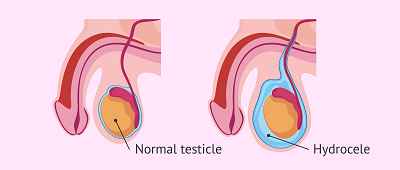What Should You Do If Orchitis Causes Hydrocele in Your Testicles?
Orchitis is an inflammatory disease of the testicles caused mainly by bacterial or viral infection. Usually, it leads to symptoms such as testicular pain, scrotal enlargement, fever, and fatigue. However, if the inflammation is not treated in time or the treatment is incomplete, it may also lead to the development of hydrocele.

What is a hydrocele?
Testicular effusion is generally referred to as hydrocele in the testicles. In males, the testicles are surrounded by a sheath membrane, forming a tiny gap in the center of the testicle called the cavity of tunica vaginalis. Every normal male has a small amount of fluid in the tunica vaginalis cavity that acts as a lubricant for testicular movement. So, hydrocele is not an abnormal concept.
However, when there is a lesion in the tunica vaginalis itself or in the testicles or epididymis, the secretion and absorption of fluid are out of balance, and excessive hydrocele can form. If there is increased fluid and increased internal pressure in the hydrocele over a long period of time, it can affect the blood flow and temperature regulation of the testicles, causing the patient's testicles to atrophy.
A relatively large amount of testicular hydrocele may also cause testicular swelling and discomfort. Hydrocele due to orchitis is cloudy and may be accompanied by bleeding, which needs to be treated aggressively.
Therefore, excessive fluid accumulation caused by orchitis can have a severe impact on the male testicles and can drive abnormal testicular development. Male patients should pay great attention to it.
What should you do if orchitis causes hydrocele in your testicles? There are several main types of treatment:
1. General Treatment:
The main thing is to do a good job of daily care, take more bed rest, and avoid strenuous exercise. Patients can relieve pain by elevating the scrotum and applying hot compresses to the scrotum to promote blood circulation, which is conducive to the absorption of inflammatory substances and the reduction of fluid accumulation.
2. Medication Treatment:
Fluid accumulation caused by orchitis, patients need to treat the inflammation in time. Once the inflammation disappears, the hydrocele will slowly return to normal. Patients should use appropriate antibacterial drugs for treatment, such as oral levofloxacin tablets, cefdinir dispersible tablets, and other drugs, or injections of ceftriaxone sodium, which can control the infection and avoid the continuous increase in the amount of effusion.
In addition, patients can also use traditional Chinese medicine Diuretic and Anti-inflammatory Pill, which has anti-inflammatory and bactericidal efficacy, can remove pathogenic bacteria and eliminate inflammation and infection; its effect of promoting blood circulation and removing blood stasis can promote blood circulation and the absorption of effusion; the efficacy of clearing away heat and detoxifying the body can promote the absorption of fluids and the secretion of balanced, to improve the condition of effusion.
3. Surgical Treatment:
When the amount of hydrocele buildup continues to increase and a significant testicular abscess forms, medication is not very effective, and surgery should be considered. Cyst incision and drainage surgery can remove the hydrocele and prevent further spread of infection. After surgery, patients should also do a good job of daily conditioning to prevent recurrence.
It should be remembered that in addition to orchitis, other factors can cause excessive hydrocele, thus affecting the normal life of men. So, men should understand and take precautions in their daily lives.
1. Reproductive Diseases: In addition to the testicles, when there are lesions in the epididymis, tunica vaginalis, spermatic cord, and other parts of the male, the normal function of the tunica vaginalis will be affected, resulting in increased secretion and oozing of hydrocele, or blockage of the lymphatic system to form an effusion.
2. Damage to the Scrotum: The tunica vaginalisr is located in the male scrotum and secretes fluid to provide lubrication for the testicles. Damage to the scrotum is likely to result in hydrocele. Surgery in the abdomen, groin area, or scrotum in men can also cause hydrocele if the spermatic cord or lymphatic vessels are irritated and damaged.
3. Germs Infection: This is a common cause of hydrocele. The main germs include Mycobacterium tuberculosis, diplococcus gonorrhea, and non-specific bacterial invasions. Orchitis and dermatitis caused by germs will cause the appearance of a hydrocele.
4. Other Diseases: Systemic diseases can also cause hydrocele. Men with generalized tissue edema or ascites, heart or kidney failure, or liver disease that obstructs reflux are all causes of hydrocele. Testicular torsion or varicocele are also causative.
You may also be interested in:
If You Have Orchitis, Why Should You Not Sit for Long?



